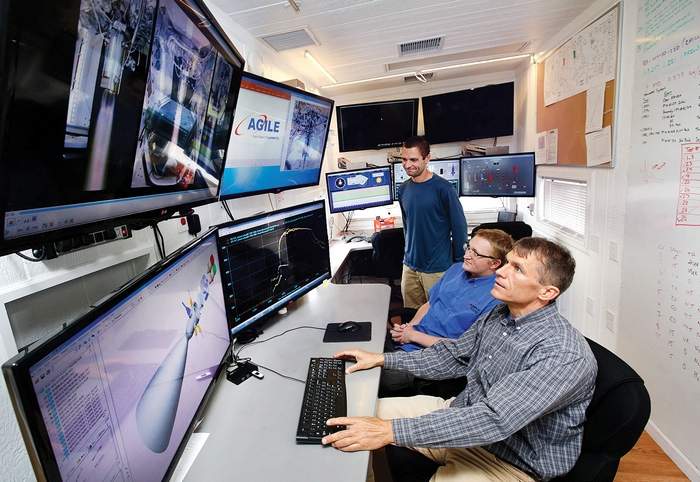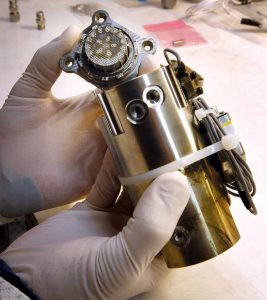
Daudi Barnes, right, works with lead analyst Mike Fitzpatrick, left, and lead design engineer Mesa Hollinbeck.
Colorado-based company Agile Space Propulsion was born from the expertise of Daudi Barnes, who has been working in the spacecraft propulsion industry since 1998. Agile Space Propulsion has a specific goal: to design and manufacture rocket engines using 3D printing technology. In particular, Barnes wants to develop thrusters, the small maneuvering engines used in rockets. According to Barnes, as rockets get cheaper, there is an increasing need for thrusters, and the miniaturization of electronics is spurring demand for more space vehicles for a variety of purposes.
“Cost reductions have opened up opportunities,” Barnes said. “People are saying: ‘Wow, if all of this is more affordable, we can do more missions now.'”
Rocket launches have been downsizing and becoming lighter and cheaper, partially thanks to 3D printing, which enables complex parts to be made in fewer components, or even in a single component. It also allows for a great deal of lightweighting.
“Weight is everything in space,” said Barnes. “It costs $1 million to put 1 kilo on the face of the moon. If you can make a spacecraft half a kilo lighter, you’re saving a ton of money.”
Agile Space Propulsion has already developed a 100-pound thruster and is currently working on a five-pound one. Barnes points to the use of 3D printing in much of aerospace, for both small and large engines.
“In traditional manufacturing, there are a lot of steps, a lot of parts, and there are restrictions on what you can do,” he said. “For instance, you can drill a straight hole, but you can’t drill a curved hole.”
3D printing, on the other hand, can create curved channels, and can cut down on the number of steps involved in making something like a thruster.
“The end product is more sophisticated, more capable and lighter, and that’s a really big thing,” said Barnes. “I can print in one day something that took months to make. Just the time savings alone is a big cost-saver.”
 Barnes has already developed a prototype thruster for a lunar lander for NASA. The thruster had languished in production for years without making much progress, due to the limitations of conventional manufacturing techniques. Using 3D printing, Barnes was able to come up with a prototype in merely nine weeks, and it performed better than the engine that had been in production for so long.
Barnes has already developed a prototype thruster for a lunar lander for NASA. The thruster had languished in production for years without making much progress, due to the limitations of conventional manufacturing techniques. Using 3D printing, Barnes was able to come up with a prototype in merely nine weeks, and it performed better than the engine that had been in production for so long.
Barnes is also the owner of Advanced Mobile Propulsion Test, which gives him access to that company’s rocket engine testing facility. This allows him to quickly iterate and test his designs.
“We use 3D printing, but the other part we have is the testing facility,” he said. “We can learn a lot when we test here. We’re uniquely diagnostic. We have very specific equipment that gives you detailed information and more certainty in the information you’re getting. We are also focused on a quick turnaround. You can get back to an engine, modify it and quickly retest.”
Barnes created Agile Space Propulsion because of a failure to land NASA grants to develop new technology, as Advanced Mobile Propulsion Test was viewed as a testing facility and not a design company. Currently self-financing the new company, Barnes is looking for $500,000 from investors. He also wants to hire a CEO to replace him so that he can focus on engineering and developing rockets. The company now has five full-time employees and three part-time employees, and works with several contractors.
Once he has completed business development, Barnes will seek an additional $5 million to enhance the company’s ability to produce thrusters.
“We’re sort of like a seed that’s planted, and we’re hoping it will take root and we will be able to grow it and sustain it,” he said.
Discuss this and other 3D printing topics at 3DPrintBoard.com or share your thoughts below.
[Source/Images: Durango Herald]Subscribe to Our Email Newsletter
Stay up-to-date on all the latest news from the 3D printing industry and receive information and offers from third party vendors.
You May Also Like
Gorilla Sports GE’s First 3D Printed Titanium Cast
How do you help a gorilla with a broken arm? Sounds like the start of a bad joke a zookeeper might tell, but it’s an actual dilemma recently faced by...
Nylon 3D Printed Parts Made More Functional with Coatings & Colors
Parts 3D printed from polyamide (PA, Nylon) 12 using powder bed fusion (PBF) are a mainstay in the additive manufacturing (AM) industry. While post-finishing processes have improved the porosity of...
$25M to Back Sintavia’s Largest Expansion of Metal 3D Printing Capacity Since 2019
Sintavia, the digital manufacturing company specializing in mission-critical parts for strategic sectors, announced a $25 million investment to increase its production capacity, the largest expansion to its operations since 2019....
Velo3D Initiates Public Offering in a Bid to Strengthen Financial Foundations and Drive Future Growth
Velo3D (NYSE: VLD) has been among a number of publicly traded 3D printing firms that have attempted to weather the current macroeconomic climate. After posting a challenging financial report for 2023,...































